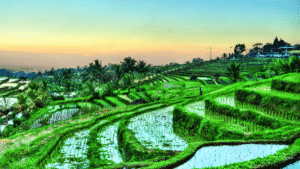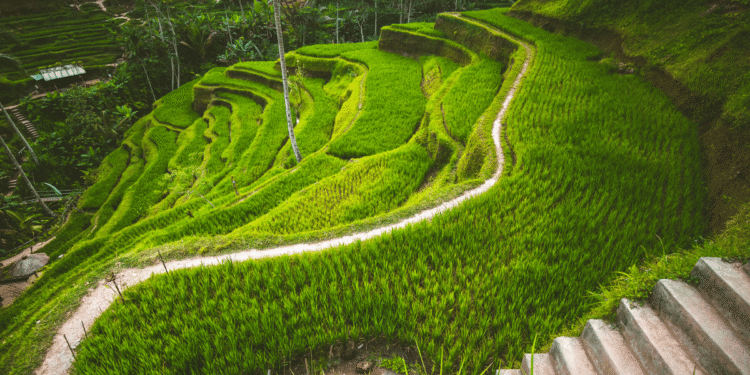Terrace farming is efficient and is one of the preferred methods in hilly farmlands. It has multiple advantages. The importance of terrace farming goes far beyond cultivating lands that are not suitable for agriculture otherwise. In addition to this, terrace farming prevents erosion of soil and contributes to its conservation. Nowadays, the method allows the growing of versatile crops, and its management is more comfortable with online agricultural software.
What Is Terrace Farming?
Terracing is an agricultural practice that suggests rearranging farmlands or converting hilly regions into farmlands by constructing specific ridged platforms. These platforms are called terraces.
The most important feature of terracing agriculture is excavating and moving topsoil to form farmed areas and ridges. The water flows down to the lower terraces from the upper terraces once they become full. Thus, the amount of water is distributed more or less evenly, not just at the foot of the hill.
Is it a necessity?
Practically, the purpose of terrace farming on slopes is to decrease water flows and prevent soil erosion. However, using it in the mountains is not just an option. Opposite graduated step-like platforms, there are relatively level ones on gentle slopes or wavy lands, which shows that terracing applies to different field elevations.
Most Common Types Of Terraces
Terraces can be of different types depending on the base, level, or tilted, other than this the soil infiltration properties also play a major role. If soil infiltration is sufficient, they are made level. Typically, outlets are not required, too.
The most popular terracing types in farming are broad-base, narrow-base, and grassed back-slope. Their choice depends on how steep the hill is. Correspondingly, not all types imply farming of all terrace slopes.
Broad-Base Terrace Farming
The farming technique is suitable for the gentlest hills, and terrace cultivation embraces all the slopes. For this reason, they should suit machinery needs, and the terrace spacing is typically equal to the number of machinery swaths. Crossing the ridges is prohibited – the equipment is supposed to move between the terraces through designated passages. Broad-base terracing is applicable on slopes up to 8%.

Grassed Back-Slope Terrace Farming
The farming type is an example of perennial terracing. As the name suggests, the back slope cover is a perennial grass. In the given terrace farming technique, the back slope is not cultivated, unlike the main part. Typically, the main part includes the soil taken from the downhill upwards, with further levelling for farming.

Narrow-Base Terrace Farming
A terrace of this type is another example of perennial terracing, but in this case, permanent vegetation covers both the front and back sides. These parts are not cultivated. Like with the grassed back slope, the earth is usually moved downhill. Yet, this is the steepest terracing type, requiring less amount of earth for platforms than others.

Terrace alignment depends on the slope steepness and the soil type. In particular, it is not suitable when lands are prone to sliding.
Terrace Farming Systems
The commonly used terracing systems are bench, contour, and parallel terraces. Their names give an idea of their layout.
Bench Terracing
Bench systems in farming resemble benches or steps across the slope, with flat or almost flat farmed platforms arranged at regular intervals. Such regular arrangement is labour-consuming and suggests intensive soil disturbance. The slopes may consist of earth proper, covered with perennial vegetation, or maybe fortified with stones.
Bench terracing in agriculture is most common for growing rice since bench terraces allow retaining water. For this reason, such a terracing layout is not suitable in the cases like:
- crops are sensitive to waterlogging, e.g., potatoes;
- lands are prone to sliding;
- frequent rains characterize weather patterns in the area.
Contour Terracing
Like in contour strip farming, these terracing systems follow the relief contour. Terraces consist of point rows and grassed waterways. Even though such platforms require less input to arrange them, they are difficult for farming activities due to space irregularities.
Parallel Terracing
Parallel constructions are the easiest for farming activities, so they should be kept as parallel as possible. If the slope does not allow that, they are built through land-levelling operations. It facilitates machinery movement, yet it is labour-, cost-, and time-consuming. In this regard, sometimes it will make sense not to treat those parts but leave them under perennial cover or as grass waterways.
How Does Terrace Farming Help In Conserving Soil?
Terracing helps retain soil cover and fertility since water flows do not wash off the topsoil and nutrients.
So, what is terracing in soil conservation?
- The slope is no longer as steep as it initially was.
- Water runoffs are slower due to levelled areas.
- Water streams do not flow on the earth’s surface as they usually do on hilly lands. Water is either collected in channels or runs under the surface via outlets and pipes.

Farming on a terrace is an efficient soil conservation practice. However, it requires regular inspection and maintenance at the same time. Thus, inefficient terrace farming, it is essential to check the ridges and grass cover, improving where necessary.
Another issue of the terracing practice is the sedimentation of channels, which is resolved by cleaning and planting buffer strips. Also, the outlets and pipes should be clean and free from vegetation residue and particles that may block them.











